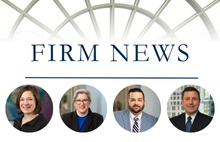Dance Dance Litigation: Lawsuits Filed over the Use of Dance Choreography in Fortnite
January 2019A series of recent lawsuits could clarify the circumstances under which copyright law covers dance choreography. This rarely litigated aspect of the Copyright Act has recently upstaged other emerging copyright developments, due to both the unusually complicated legal issues involved and the potentially far-reaching implications of the cases.
Alfonso Ribeiro has filed a lawsuit against Epic Games, the maker of the 2017 video game Fortnite Battle Royale, over the virtual rendering of a dance sequence made famous by Ribeiro's character Carlton Banks on the television show The Fresh Prince of Bel-Air. The dance, an energetic performance including wide arm sways and hip movements, is now known as “The Carlton” and has been immortalized in Internet memes as a visual shorthand for excitement or enthusiasm.
Fortnite is a “last player standing” multi-player arena game in which players battle to be the only remaining contestant or team. Though free to play, Fortnite has made over $1 billion for Epic Games through microtransactions by which players purchase and spend virtual currency to modify their in-game characters. These modifications include the dance move “Fresh” (for roughly $8.00), which allows the player’s virtual character in the game to perform “The Carlton.”
On December 17, 2018, Ribeiro sued Epic Games over the use of the dance. Two other performers independently sued Epic Games over the use of their dances in Fortnite. Terrence Ferguson, a rapper more commonly known by his stage name, “2 Milly,” sued over the use of his “Milly Rock” dance. Russell Horning sued over the use of the “Floss,” a dance in which the body is almost completely still, but the arms move quickly side to side in front of and behind the body.
In addition to claims under California law, each performer contends that Epic Games violated federal intellectual property rights in his respective dance choreography by digitally replicating the dances’ signature moves in Fortnite without permission. The performers seek damages and injunctions preventing Epic Games from using their dances in Fortnite. The plaintiffs raise claims under both trademark and copyright law. Although the current iteration of the Copyright Act provides intellectual property protection for dance choreography, this area of law has not been heavily litigated, and there is little guidance from courts on how it should be applied. In a circular published in September 2017, the U.S. Copyright Office summarized available case law and the legislative history of the Copyright Act and stated that although individual dance movements, short routines of only a few steps with only minor variations, and social dances (e.g., square dances) were not copyrightable, an extended series of dance moves original to the creator can be copyrighted under certain circumstances. For example, the general requirement of all copyrights that the work be “fixed in a tangible means of expression” (e.g., a recording of the dance performance, or written dance notation) also applies to dance choreography.
Each of these cases raises challenging issues for the plaintiffs. Copyrights are generally available only to the original authors, but Ribeiro has previously made statements suggesting that “The Carlton” might not fully originate with him, because he incorporated moves from a dance routine in Eddie Murphy’s “Raw” and a music video for Bruce Springsteen’s “Dancing in the Dark.” Ribeiro might also have to address whether “The Carlton” was originally performed subject to the “work made for hire” doctrine, which states that when an employee creates a new copyrightable work in the scope of his employment, the employer is normally considered the author (and copyright owner) of the work. If this doctrine applies, any copyright in the dance may instead be found to belong to his employer at the time, the producers of The Fresh Prince of Bel-Air.
Regarding the “Milly Rock” and the “Floss,” it is unclear whether the dances are sufficiently complex to merit copyright protection. Both of them are simpler than “The Carlton,” and the “Floss” in particular is a combination of only a few moves performed repetitively. The courts could conclude that no copyright subsists in these dances at all, leaving only trademark and state law claims to protect them.
However, even if the dance choreography itself is found not to be copyrighted, the videos portraying the performances might themselves be separately copyrightable as audiovisual works. This in turn raises questions as to whether the use of the dance moves shown in the videos infringes the copyright in the videos themselves.
A related issue is whether the plaintiffs currently have standing to assert these claims at all. Although these dances are not currently registered with the Copyright Office, all three performers have filed applications for registration. However, not all federal courts will allow a copyright lawsuit to proceed on the basis of an application alone. Some require that the plaintiff submit an actual registration certificate issued by the Copyright Office. The current circuit split over this issue is expected to be resolved by the U.S. Supreme Court in Fourth Estate Public Benefit Corp. v. Wall-Street.com, LLC, which was argued on January 9, 2019. If the Supreme Court requires full registration, these three lawsuits against Epic Games might have to first await a registration decision by the Copyright Office before proceeding.
Epic Games need not wait out these decisions, however, and could instead choose to settle these cases. In a prior dispute, Epic Games did settle with Gabby David, a Los Angeles choreographer, who noticed that an original dance that she posted to YouTube was later added to Fortnite as the “Electro Shuffle” emote, without her permission.
Intellectual property law is complex and challenging, both for creators of copyrighted works and for those who wish to use the works of others. This is particularly true in an increasingly digital world. The Internet has made it exceedingly easy to copy such works and for creators (or copyright trolls) to discover if works have been copied.
If you have questions about how to protect your creative works and inventions, license the works of others, or respond to an accusation of infringement, the intellectual property attorneys at Lewis Rice can help.








